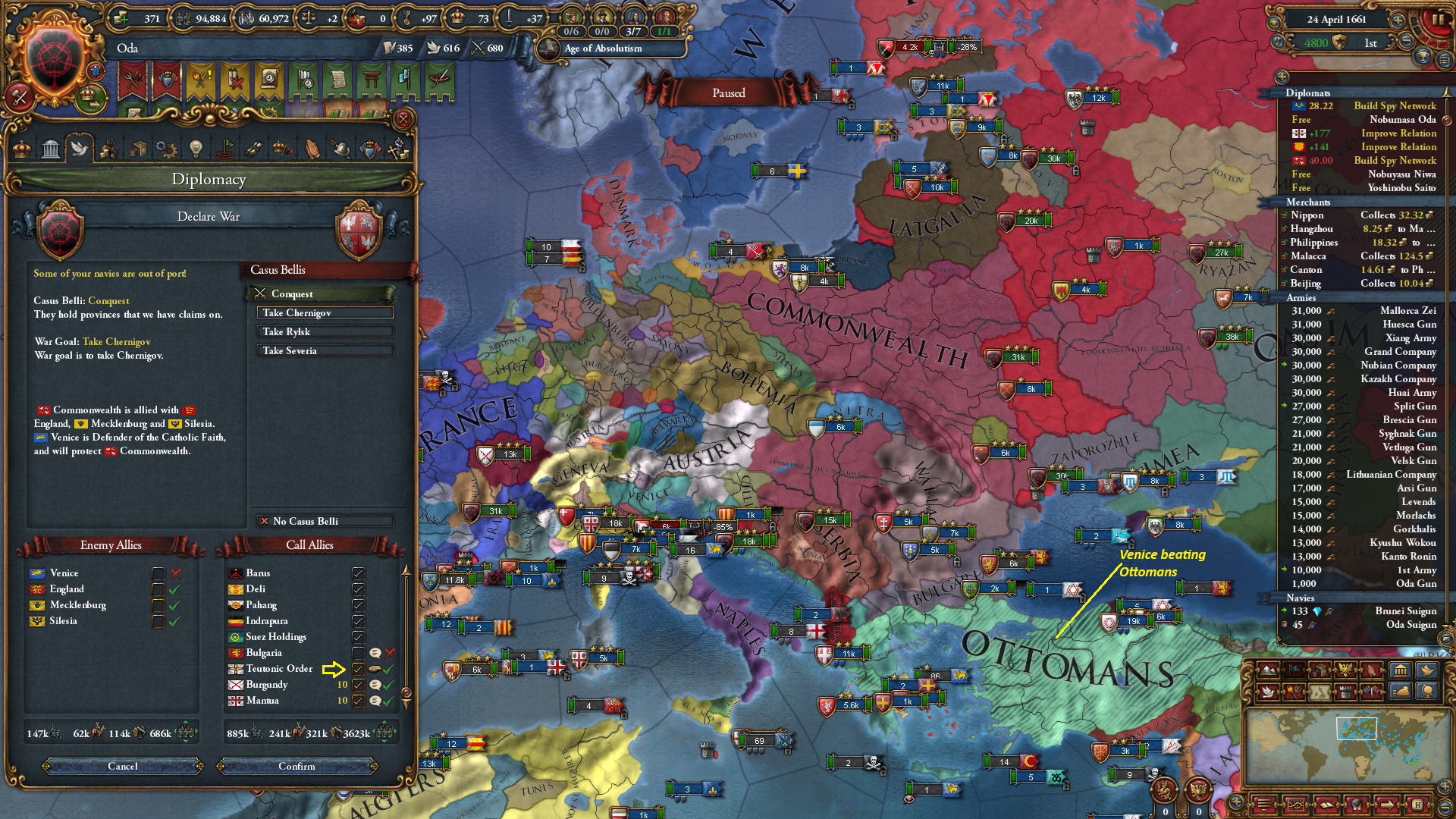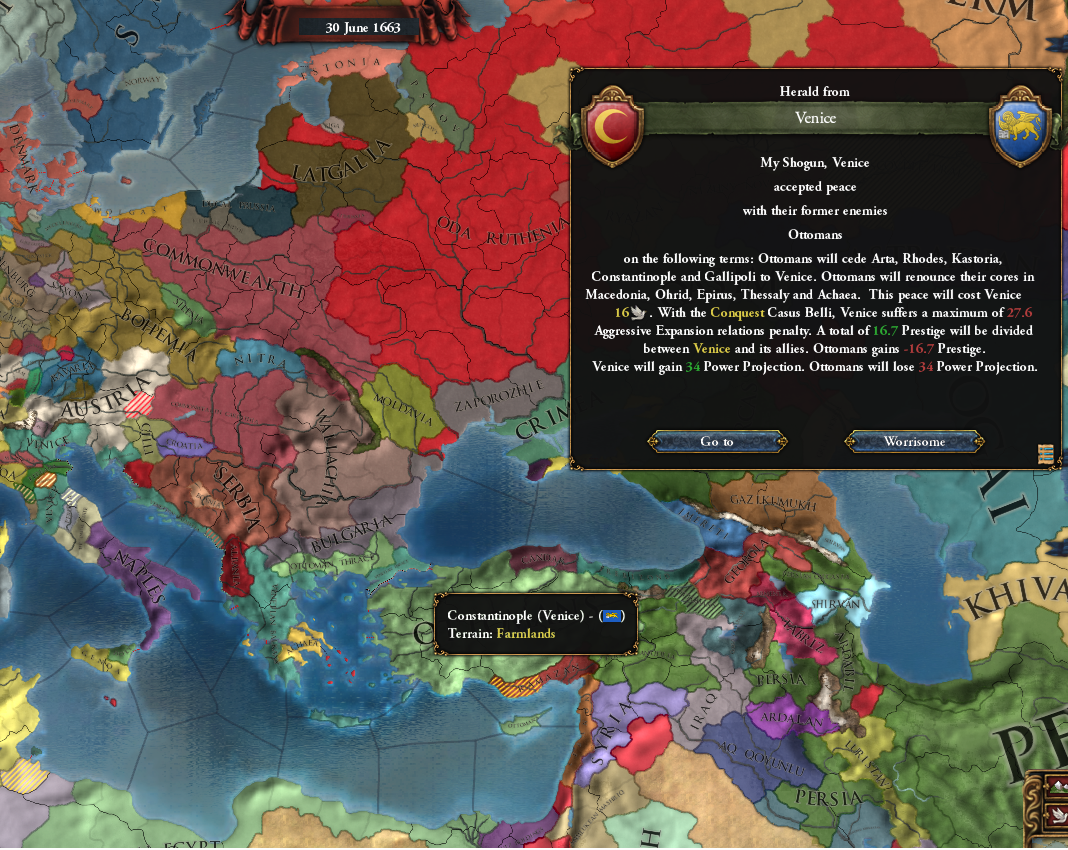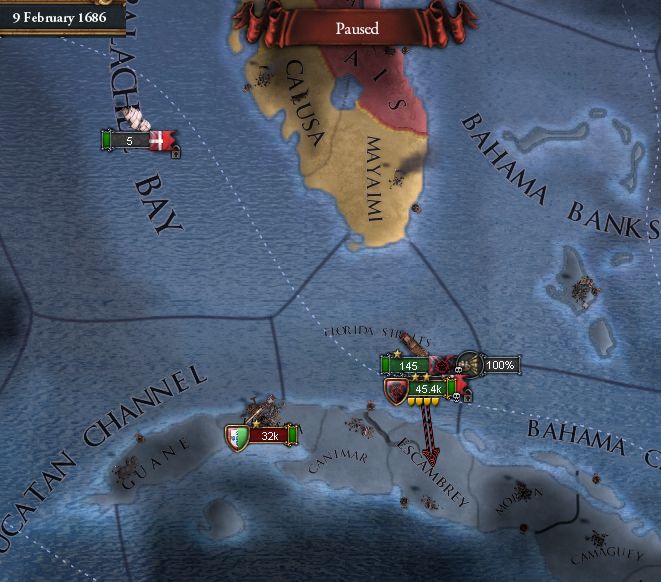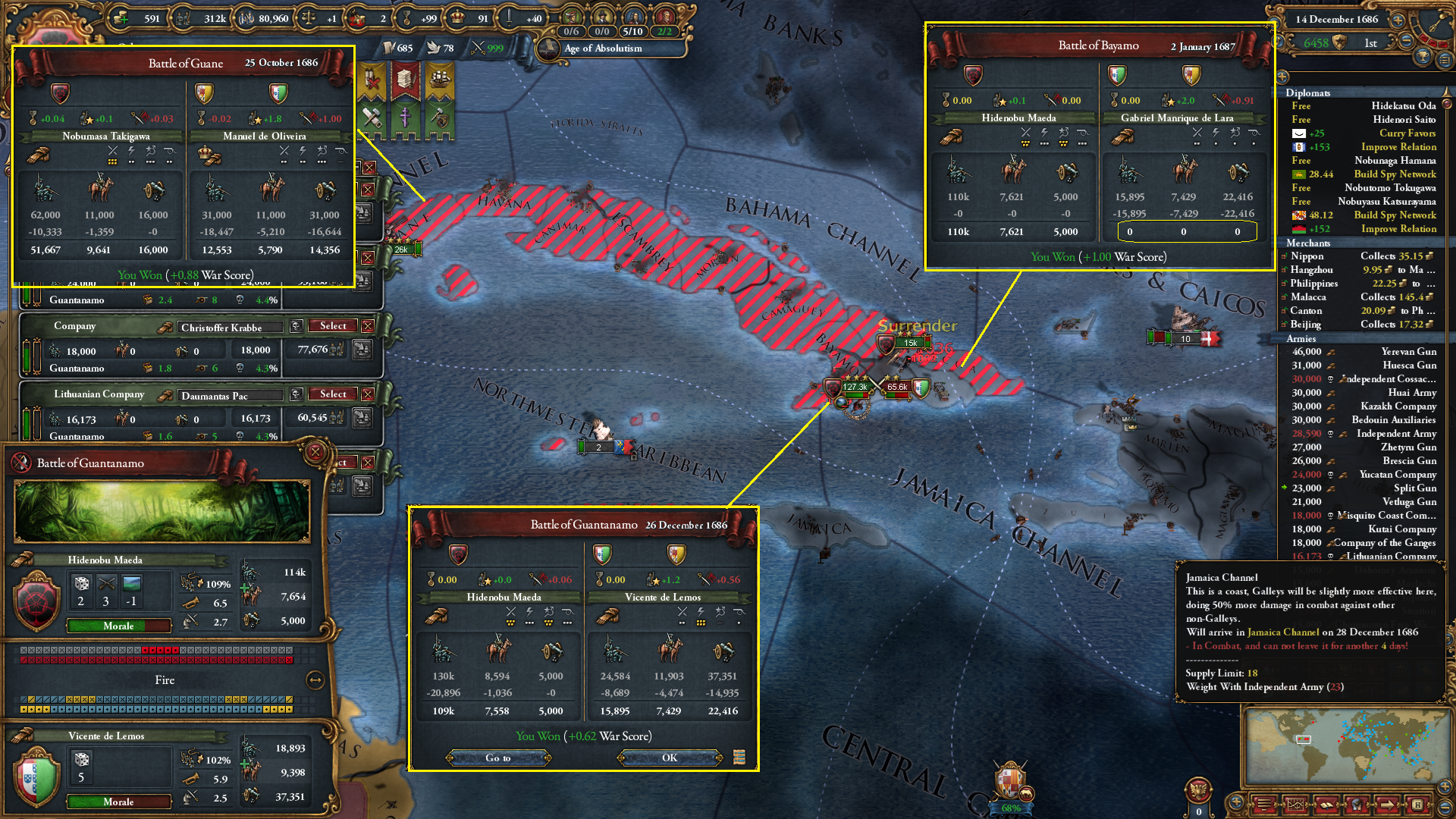Chapter 22: Boxing Them In (1660-1670)
The highlight of the last decade was a war against Persia that left that empire surrounded on most sides by Oda and her subjects. This decade continued this trend. But first Oda adopted Manufactories institution, about 11 years late.

During that time, all the newly released Indian nations ( Mysore, Venad, Golkonda etc ) were made into Daimyos, and troops moved ( slowly ) through central Asia towards the Pontic steppes in anticipation of war with Commonwealth. That war was declared in April 1661

On the Polish side was England again, as well as German minors Silesia and Mecklenburg. Luckily, Venice who was defender of the Catholics declined to help them this time, as they were tied up in an Ottoman war ( as you may recall, Venice was a thorn in Oda's side in the last war with Poland). On Oda's side was the future vassal Teutonic Order who was promised land ( fatten them before eating them) . Mantua and Burgundy were included to prevent them from getting larger during peacetime.
The most interesting fighting happened in Britain, where an Odan siege army quickly took the English capital (York). But then its commander went on a foolhardy advance against the English forces that retreated into the Highlands of Scotland. There he suffered a defeat due to the poor army composition, which as mostly artillery suitable for siege and not land warfare

But of course, as one would expect for a nation with vast resources like Oda, regrouping in Britain was easily done with mercenaries and reinforcements. The offensive was retaken and soon enough the English were made to sign peace

The English were forced to return 3 provinces to Scotland, which was as large as Scotland could get before becoming ineligible for diplo-vassalization. And immediately the shogun started improving relations with Scotland, as well as currying favors in hope of improving trust to get them to accept the proposal.

The war with Poland was then prosecuted vigorously until they were willing to accept a near unconditional peace

Here the Shogun had the problem of not having any nations to release as Daiymos, with the exception of Hungary (which would have been the only peace treaty item, and would be too large to vassalize). Instead of releasing a very large Hungarian nation, he decided to have Oda annex the former Lithuanian provinces in the Russo-Ukrainian plain , provinces that were Orthodox religion . This was made with an eye towards future conversion to Orthodox religion , but also as a way to box in Commonwealth and make future wars against them easy , and deny them avenues for expansion. Furthermore, the Shogun reasoned that with Hungary geographically separated from Poland, rebels may one day achieve Hungarian independence , saving Oda a full war.
In addition to annexing the Orthodox land, Oda also gave her ally Teutonic Order 2 provinces ( they did not want more) and her tributary Moldavia 3 provinces. The tributary treaty with Moldavia was then broken and replaced with an alliance, as a step towards making Moldavia a Daimyo. This was as much expansion as Oda could do without incurring more aggressive expansion .
An immediate upshot of the peace treaty was giving Orthodoxy a plurality among Oda's mix of faiths.

Following the victory over the Commonwealth, war was declared on Spain .

This time Venice decided to Defend their fellow Catholics, even though they had not completed their war against Ottomans. And just like the previous war with Spain, Venice was the toughest opponent thanks to their strong fleet

One effect of Venice fighting Oda was the early conclusion of the Venetian-Ottoman war, which ended up with Venice taking Constantinople and a few other Greek provinces.

The Shogun was pleased to see the Ottoman Empire continue to shrink , but was unhappy to see Venice rise. And a few months later he forced Venice to part away with two Italian provinces , one going to newly independent Milan ( a future Daimyo) and one to Oda ally Mantua .

That left Spain as the only enemy remaining . And to maximize Japan's' negotiating position [warscore] , the remote islands of Mauritius and Bourbon in the Indian Ocean, and the Canarias in the Atlantic were occupied by Odan troops. Another boost to Oda's negotiating ability was the adoption of "Diving Right" as the 10th government reform [ -5% warscore cost vs other religions].

Between that and the passage of time , Spain was eventually forced to part with almost all her coastal provinces in Europe , Africa , Asia and Oceania

The Shogun prioritized acquisition of Spain's outlying provinces rather than her main holding in Iberia so that in a future war, a complete occupation would be much faster for Oda to do . The last thing Oda wanted to have to deal with was sieging a fort on a remote island in the Pacific, and the easiest way to avoid that was to annex those provinces while Spain's center of gravity was in easy to conquer Iberia ( an ironic situation for a country based in japan, to consider Iberia "closer" than the Pacific)
With Spain thus boxed in, it was time to continue the rotation of Empire bashing by moving against France. But before that war was begun, Oda scored one of her best diplomatic coups when Scotland was made into a large Daimyo

Considering that Oda had been at war with Scotland before ( most of Oda's Irish vassals were released from Scotland, not England) , having the Scots accept vassal status was a veritable tour de force. Oda's control of the British Isles was becoming more and more unassailable.
After that , Oda declared on France.

Again Venice was on the enemy side , defending the Catholics. But this time Venice was easier to defeat, having recently been beaten up in war already. After taking the fort of Treviso, the armies of Oda and her swarm descended on Venice city and defeated the garrison there.

The loss of Venice doomed the Venetians, even though their navy turned out to still be superior to Japan's . After their forts of Split and Istria fell, the agreed to this peace

Venice released Dalmatia as a free nation, but not before ODa took one province off of Dalmatia. That was to ensure that Dalmatia would be small enough to turn into a Daimyo after the peace ( no repeating the Syria mistake). Then after peacing out Oldenburg, France was forced to sign this:

The peace was similar to that imposed on Spain earlier. Since France had no more nations to release, ODa was forced to annex land directly . Oda took all of France's coastline on the Channel and Mediterranean. This made the main French holdings a landlocked entity. The only ports France kept were in London, Gelre and Flanders. All the annexed provinces were distributed among the various Daimyos with one major exception. And that was the provinces in the Channel. Here Oda created the new client state of Normandie [i explain why in a separate post] by "spawning" it off the province of Calais given to the Suez HOldings client state during the war.


To help facilitate French loss of their remaining ports, Gelren rebels were supported and England cheered on when she declared reconquest on France.


And these would be the last notable events of the decade. ODa is preparing to move against Persia again, who has replaced Ottomans in the rotation

The highlight of the last decade was a war against Persia that left that empire surrounded on most sides by Oda and her subjects. This decade continued this trend. But first Oda adopted Manufactories institution, about 11 years late.

During that time, all the newly released Indian nations ( Mysore, Venad, Golkonda etc ) were made into Daimyos, and troops moved ( slowly ) through central Asia towards the Pontic steppes in anticipation of war with Commonwealth. That war was declared in April 1661

On the Polish side was England again, as well as German minors Silesia and Mecklenburg. Luckily, Venice who was defender of the Catholics declined to help them this time, as they were tied up in an Ottoman war ( as you may recall, Venice was a thorn in Oda's side in the last war with Poland). On Oda's side was the future vassal Teutonic Order who was promised land ( fatten them before eating them) . Mantua and Burgundy were included to prevent them from getting larger during peacetime.
The most interesting fighting happened in Britain, where an Odan siege army quickly took the English capital (York). But then its commander went on a foolhardy advance against the English forces that retreated into the Highlands of Scotland. There he suffered a defeat due to the poor army composition, which as mostly artillery suitable for siege and not land warfare

But of course, as one would expect for a nation with vast resources like Oda, regrouping in Britain was easily done with mercenaries and reinforcements. The offensive was retaken and soon enough the English were made to sign peace

The English were forced to return 3 provinces to Scotland, which was as large as Scotland could get before becoming ineligible for diplo-vassalization. And immediately the shogun started improving relations with Scotland, as well as currying favors in hope of improving trust to get them to accept the proposal.

The war with Poland was then prosecuted vigorously until they were willing to accept a near unconditional peace

Here the Shogun had the problem of not having any nations to release as Daiymos, with the exception of Hungary (which would have been the only peace treaty item, and would be too large to vassalize). Instead of releasing a very large Hungarian nation, he decided to have Oda annex the former Lithuanian provinces in the Russo-Ukrainian plain , provinces that were Orthodox religion . This was made with an eye towards future conversion to Orthodox religion , but also as a way to box in Commonwealth and make future wars against them easy , and deny them avenues for expansion. Furthermore, the Shogun reasoned that with Hungary geographically separated from Poland, rebels may one day achieve Hungarian independence , saving Oda a full war.
In addition to annexing the Orthodox land, Oda also gave her ally Teutonic Order 2 provinces ( they did not want more) and her tributary Moldavia 3 provinces. The tributary treaty with Moldavia was then broken and replaced with an alliance, as a step towards making Moldavia a Daimyo. This was as much expansion as Oda could do without incurring more aggressive expansion .
An immediate upshot of the peace treaty was giving Orthodoxy a plurality among Oda's mix of faiths.

Following the victory over the Commonwealth, war was declared on Spain .

This time Venice decided to Defend their fellow Catholics, even though they had not completed their war against Ottomans. And just like the previous war with Spain, Venice was the toughest opponent thanks to their strong fleet

One effect of Venice fighting Oda was the early conclusion of the Venetian-Ottoman war, which ended up with Venice taking Constantinople and a few other Greek provinces.

The Shogun was pleased to see the Ottoman Empire continue to shrink , but was unhappy to see Venice rise. And a few months later he forced Venice to part away with two Italian provinces , one going to newly independent Milan ( a future Daimyo) and one to Oda ally Mantua .

That left Spain as the only enemy remaining . And to maximize Japan's' negotiating position [warscore] , the remote islands of Mauritius and Bourbon in the Indian Ocean, and the Canarias in the Atlantic were occupied by Odan troops. Another boost to Oda's negotiating ability was the adoption of "Diving Right" as the 10th government reform [ -5% warscore cost vs other religions].

Between that and the passage of time , Spain was eventually forced to part with almost all her coastal provinces in Europe , Africa , Asia and Oceania

The Shogun prioritized acquisition of Spain's outlying provinces rather than her main holding in Iberia so that in a future war, a complete occupation would be much faster for Oda to do . The last thing Oda wanted to have to deal with was sieging a fort on a remote island in the Pacific, and the easiest way to avoid that was to annex those provinces while Spain's center of gravity was in easy to conquer Iberia ( an ironic situation for a country based in japan, to consider Iberia "closer" than the Pacific)
With Spain thus boxed in, it was time to continue the rotation of Empire bashing by moving against France. But before that war was begun, Oda scored one of her best diplomatic coups when Scotland was made into a large Daimyo

Considering that Oda had been at war with Scotland before ( most of Oda's Irish vassals were released from Scotland, not England) , having the Scots accept vassal status was a veritable tour de force. Oda's control of the British Isles was becoming more and more unassailable.
After that , Oda declared on France.

Again Venice was on the enemy side , defending the Catholics. But this time Venice was easier to defeat, having recently been beaten up in war already. After taking the fort of Treviso, the armies of Oda and her swarm descended on Venice city and defeated the garrison there.

The loss of Venice doomed the Venetians, even though their navy turned out to still be superior to Japan's . After their forts of Split and Istria fell, the agreed to this peace

Venice released Dalmatia as a free nation, but not before ODa took one province off of Dalmatia. That was to ensure that Dalmatia would be small enough to turn into a Daimyo after the peace ( no repeating the Syria mistake). Then after peacing out Oldenburg, France was forced to sign this:

The peace was similar to that imposed on Spain earlier. Since France had no more nations to release, ODa was forced to annex land directly . Oda took all of France's coastline on the Channel and Mediterranean. This made the main French holdings a landlocked entity. The only ports France kept were in London, Gelre and Flanders. All the annexed provinces were distributed among the various Daimyos with one major exception. And that was the provinces in the Channel. Here Oda created the new client state of Normandie [i explain why in a separate post] by "spawning" it off the province of Calais given to the Suez HOldings client state during the war.


To help facilitate French loss of their remaining ports, Gelren rebels were supported and England cheered on when she declared reconquest on France.


And these would be the last notable events of the decade. ODa is preparing to move against Persia again, who has replaced Ottomans in the rotation

- 1
- 1




































































































































